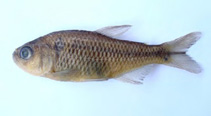| Family: |
Characidae (Characins; tetras), subfamily: Stethaprioninae |
| Max. size: |
6.48 cm SL (male/unsexed) |
| Environment: |
pelagic; freshwater; depth range 0 - 1 m |
| Distribution: |
South America: Rio Jequitinhonha basin, Minas Gerais, Brazil. |
| Diagnosis: |
Dorsal spines (total): 2-2; Dorsal soft rays (total): 9-9; Anal spines: 2-3; Anal soft rays: 18-21. Astyanax turmalinensis differs from the other species of the genus by the following combination of characters: presence of 20 to 24 anal fin rays; 34 to 36 scales in lateral lines; 1 or 2 teeth in the maxillary bone; greatest body depth at pelvic fin origin; caudal peduncle oval spot horizontally elongated, prolonging into median caudal fin rays, onward becoming a dark band laterally on the body, tapering anteriorly, to a point slightly anterior to middle of standard length; humeral black spot present, truncate anteriorly, usually circular posteriorly, extending anteroventrally, followed by a clear area and then subsequentely a vertically elongated dark area of loosely-assembled chromatophores. Snout slender, about the same mength as eye diameter; four teeth in the outer row of the premaxillary bone; posterior border of anal fin concave anteriorly. |
| Biology: |
|
| IUCN Red List Status: |
Least Concern (LC); Date assessed: 07 November 2018 Ref. (130435)
|
| Threat to humans: |
harmless |
Source and more info: www.fishbase.org. For personal, classroom, and other internal use only. Not for publication.

